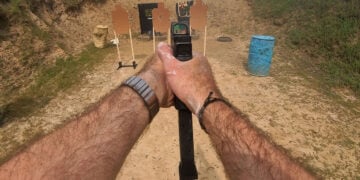When we think of the quintessential “ideal” concealed carrier, you may imagine some incredibly tacticool dude with a super modified concealed carry handgun, twelve magazines, and awesome sunglasses. The reality is that with 12+ million estimated concealed carriers in the country, there’s absolutely no way of knowing who’s carrying what and where.
In this article, we’re going to talk about some skills that you probably didn’t think help out a concealed carrier but absolutely do.
#1: Knitting
Knitting isn’t just for grandmas and expecting mothers. It requires a decent amount of manual dexterity, repetitive movements, and discipline. All of those factors translate nicely into shooting and carrying concealed. Manual dexterity is one of the best skills you can have as a concealed carrier. The ability to nimbly manipulate and maneuver your firearm both in and out of the holster is a skill that long-time veterans of the firearms community still seek to master.
#2: Aerobics (also High-Intensity Interval Workouts)
The first thing that happens when you encounter a high-stress situation is that you get a jolt of adrenaline. This can cause people to lock up. It can even, in extreme cases, cause people to faint, throw up, or even go into cardiac arrest. Aerobics and High-Intensity Interval Workouts all provide your body some conditioning to prepare for dealing with high beats per minute.
Read More: 5 Best Workouts For Concealed Carriers
#3: Paintball or Airsoft
Neither paintball or airsoft should be substituted for firing and training with your everyday concealed carry handgun. Both, however, teach basic lessons in cover, concealment, targeting priorities, and movement. While not all lessons will have a 1:1 ratio of success in carry-over, you will at least have a basic understanding of moving, communicating, taking cover, and potentially returning fire.
#4: Gardening
Did you know Japanese samurai had to take up other skills outside of martial arts? Japanese warriors would practice calligraphy, flower arrangement, and even gardening. Gardening teaches patience and promotes attention to detail. Those are skills useful for anyone potentially engaging in a life or death situation.
#5: Ice Hockey
Maybe I’m partial from growing up in the frozen, icy North but I think hockey is an excellent experience for a concealed carrier. While I wouldn’t recommend losing any teeth for an outside to jump into the practice, there is a refined sense of balance and ruggedness that can help a person survive even in traumatic times.
#6: Golf
Golf is all about subtleties. Too much force and the ball goes too far. Too much swerve, and the ball flies off course. Every little action has a direct, tangible consequence that can make your life much more pleasant or incredibly difficult. And, added to that, there is stamina. Playing 18 holes of golf requires a dedication no matter if you’re having a good day or a bad day. Dealing with adverse situations — sometimes caused in part by yourself — is an important and sobering reality check for any concealed carrier.
#7: Dancing and Ballet
Salsa dancing isn’t just for date night with your significant other – it also pays off in your defensive mindset. Getting used to predictable movements in unpredictable environments is something that can be learned in a number of ways. Dancing and ballet teach repetition, balance, and fluidity of movement. All of these things play an incredible role in using a firearm to defend yourself.
#8: Video Games
Hand and eye coordination coupled with problem-solving, navigation, and communication are all pieces of the concealed carry pie. While not a substitute for actual training, video games can help a person spatially adapt under stress.
#9. Yoga
Don’t laugh. Yoga isn’t just about opening chakras. There’s a big breathing fundamental to the practice of yoga called pranayama. Pranayama relates to controlling breathing. Breathing is an essential, basic fundamental of marksmanship. The better you can control your breathing – especially in times of extreme stress – the more able you are to assess and handle the situation. This can translate well if you ever are stuck in the unfortunate situation of needing to defend your life from an attacker.
Most importantly, it can help you de-escalate yourself if a situation is getting tense but may not require violence to resolve.
#10: Darts
Simple hand-eye coordination is easier said than done. Knowing the weight of the object in your hand, aligning that object to the target, and adjusting accordingly are all fundamentals of marksmanship.
In conclusion, it’s not always the skills you think will pay off that do. The practice of carrying a concealed handgun requires patience, repetition, and building good habits. All of these pillars can be reached from other avenues outside of directly firing a gun — though directly firing and practicing with a firearm are incredibly important.









